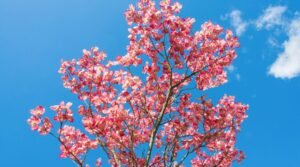
The Golden Glory: A Biography of Cassia Fistula
Perhaps the single most fascinating deciduous tree that has entranced all botanists, poets, and gardeners alike is Cassia fistula popularly known as the golden shower tree. Not only does it display pendant bunches of bright yellow flowers, but this species has also found favor in culture and traditions, ecology, and even medicine. This article discusses the intriguing life of Cassia fistula, its history, unusual features, ecological value, and the lasting relationship it nurtures with cultures.
Delivering classification and origin
The golden shower tree, or Cassia fistula, belongs to the family Fabaceae, praised for its diverse flowering plants. It is native to the Indian subcontinent and South-East Asia and grows mostly in tropical and subtropical regions.
The taxonomy of the tree is:
Kingdom: Plantae
Order: Fabales
Family: Fabaceae
Genus: Cassia
Species: Cassia fistula
The name fistula is derived from Latin meaning pipe or tube, which refers to its hollow seed pods. Through centuries it has now happened to reach other parts of the world like Africa, the Americas, and Australia, and there it is cultivated for ornamental as well as medicinal use.
Physical Description
Growth and Structure
Cassia fistula is a medium-sized tree that can normally attain a height of 10 to 20 m (33 to 66 ft). Its trunk with straight length is clad in rough, greyish-brown bark providing a fine contrast to its bright colored flowers. The canopy is open and irregular through which sunlight falls on delicate leaves.
aves or Leaves. The leaves of Cassia-fistula are alternate pinnate leaves measuring about 30 to 40 centimeters in length. Each leaf bears 4 to 8 pairs of ovate leaflets, bright green and smooth. Thus, they add to the ornamental beauty of the tree.
Flowers.

The Golden Shower Tree is famous for its beautiful flower display. The pendant racemes are produced in profusion on this tree during late spring through early summer, growing to lengths of around 40 centimeters and often longer. Each raceme can contain a multitude of bright yellow, five-petaled flowers, emitting a soft sweet-scented fragrance, attracting pollinating agents like butterflies and bees.
Fruits and seeds form a tree after flowering by cylindrical seed pods which contain up to 60 centimeters lengths. These dark brown pods contain a number of seeds embedded in a sticky sweet pulp and at the same time act as aesthetic value for the trees.
Ecological Role
Cassia fistula is an important tree in the ecosystems where it is endemic. The form of the flowers attracts numerous pollinators in the form of bees, butterflies, and birds, thus fulfilling this species propagation. Birds take cover and nest among its dense foliage while the seed pods serve as food to some animals.
Tree nitrogenous fixing causes improvement of soil health which supports reforestation programs and its being used as a companion plant in agroforestry systems.
Cultural Significance Symbolism: Cassia fistula is entrenched into culture and religion in its country of origin India. The Hindi name “Amaltas” itself is a tree, which is considered pure and rich as it is believed to relate to Vishu, the New Year.
Medicinal Uses
The various parts of the plant Cassia fistula have been used since time immemorial by the ancient medical systems such as Ayurveda and Siddha for their curative properties. The pulp of seed pods is usually laxative and used in the treatment of constipation. Decoctions using the bark and roots have been used for treating skin diseases, fever, and inflammation.
Modern studies have validated some of these uses because current studies revealed that bioactive compounds present in the extracts of the tree had antimicrobial, anti-inflammatory, and antioxidant properties.
Cultivation and Care
Ideal Conditions
Cassia fistula grows well in tropical and sub-tropical regions, prefers well-drained soils, and full exposure to sunlight. It is drought resistant and survives a lot of kinds of soil, thus making it a good low maintenance landscaping plant.
Propagation
The tree can also be propagated by means of seeds or cuttings. However, seeds readily require pre-treatment such as immersion in water or scarification before sowing to break the seed coat for germination, resulting in better germination rates and healthy sapling development.
Pruning and Maintenance
Pruning is essential to maintain the desired shape and promote vigorous growth of the tree. Regular removal of dead or diseased branches provides a lively and aesthetically pleasant canopy. Fertilization during the growing season can induce flowering and overall vigor.
Problems and Threats
Although it is quite hardy, Cassia fistula suffers from some problems such as pests, diseases, and environmental stress. The major ones include:
Pests: Some of the caterpillars, aphids, and scale insects damage the foliage and flowers.
Diseases: The tree may be affected with powdery mildews or other kinds of fungal infections especially in humid climates.
Environmental Stress: Extreme cold or flood conditions can hinder the growth and survival of the tree.
Integrated pest management strategies along with the proper watering practices and timely pruning can all help alleviate these problems.
Modern Uses
Ornamental Landscaping
The golden shower tree is very famous and patronized by most people in beautifying their urban areas and personal gardens owing to its magnificent features and easy maintenance. Mostly, they grow on roadsides, park areas, and gardens where these trees are endowed with this golden bloom display.
Environmental Restoration
Cassia fistula is used in reforestation and soil conservation due to its ability to adapt to the sometimes degraded soils as well as an increase in the nitrogen content it contributes to such soil. Its resistances and ecological benefits make it one of the most important components in the fight against deforestation and land degradation.
Economic Value
This tree serves as timber for making furniture, tools, and fuel, and it has medicinal extracts used in pharmaceutical and cosmetic industries, making it an important economic tree.
Frequently Asked Questions (FAQs)
- Does Cassia fistula have toxic properties in humans or animals?
While the pulp inside the seed pods is edible and used for traditional medicine, the seeds are thought to be toxic if consumed in large amounts. It is advisable to take care, especially with children and pets.
- How many years does it take for a golden shower tree to bloom?
Cassia fistula flowers in about 3 to 5 years, and proper care in regard to sunlight and nutrients in the soil will induce a quicker flowering.
- Is cold climate friendly for Cassia fistula?
The tree is tropical and subtropical and frost sensitive. It prefers greenhouses in colder regions or potted culture for winter indoors.
- What are the medicinal properties of Cassia fistula?
The pulp of the seeds is considered a natural laxative. Decoctions made from its bark and roots are used as curatives for skin diseases, fever, and inflammation but it is best to consult your doctor before use.
- How am I making Cassia fistula?
The process of seed propagation is used in the plant. A pretreatment is somewhat missing that can be done before germination. The seeds should be soaked in warm water for some time or scarified at different points on the surface for better germination.
- What is special about golden shower tree?
Golden shower tree, no doubt looks very beautiful and useful with its brilliant golden blossoms, cultural importance, ecological benefits attached to it and certainly medicinal properties.
The golden shower tree stands as a magnificent golden treasure of nature, with its enchanting presence and myriad benefits. Its resilience, beauty, and cultural importance continue to arouse wonder and admiration the world over.




